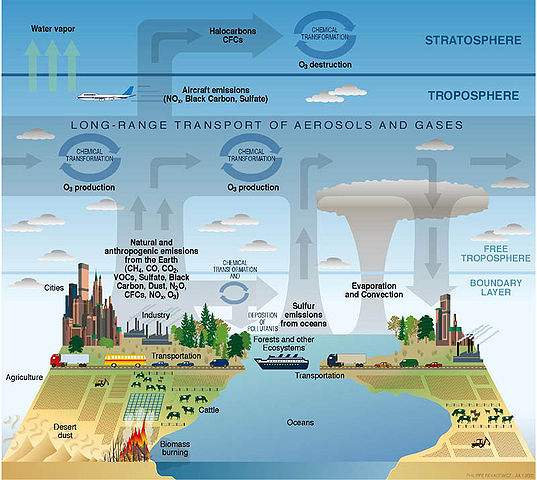User:Milton Beychok/Sandbox: Difference between revisions
imported>Milton Beychok No edit summary |
imported>Milton Beychok mNo edit summary |
||
| Line 1: | Line 1: | ||
{{Image|Atmosphere composition diagram.png|right|537px|The evolution and/or cycles of various elements in Earth's atmosphere.}} | |||
'''Atmospheric science''' is the umbrella term for the study of the [[Earth's atmosphere|atmosphere]] — the blanket of [[air]] covering the [[Earth]]. It is a relatively new discipline that is concerned with the composition, structure and evolution of the atmosphere as well as its processes and how those processes interrelate with other systems.<ref name=Hobbs>{{cite book|author= Peter V. Hobbs and John M. Wallace|title=Atmospheric Science: An Introductory Survey|edition=2nd Edition|publisher=Academic Press|year=2006|id=ISBN 0-12-732951-X}}</ref><ref name=Chandra>{{cite book|author=A. Chandrasekar|title=Basics of Atmospheric Science|edition=|publisher= PHI Learning|year=2010|id=ISBN 8120340221}}</ref><ref name=BLS>[http://www.bls.gov/oco/ocos051.htm Bureau of Labor Statistics: Occupational Outlook Handbook, 2010-11 Edition: Atmospheric Scientists]</ref> | '''Atmospheric science''' is the umbrella term for the study of the [[Earth's atmosphere|atmosphere]] — the blanket of [[air]] covering the [[Earth]]. It is a relatively new discipline that is concerned with the composition, structure and evolution of the atmosphere as well as its processes and how those processes interrelate with other systems.<ref name=Hobbs>{{cite book|author= Peter V. Hobbs and John M. Wallace|title=Atmospheric Science: An Introductory Survey|edition=2nd Edition|publisher=Academic Press|year=2006|id=ISBN 0-12-732951-X}}</ref><ref name=Chandra>{{cite book|author=A. Chandrasekar|title=Basics of Atmospheric Science|edition=|publisher= PHI Learning|year=2010|id=ISBN 8120340221}}</ref><ref name=BLS>[http://www.bls.gov/oco/ocos051.htm Bureau of Labor Statistics: Occupational Outlook Handbook, 2010-11 Edition: Atmospheric Scientists]</ref> | ||
Revision as of 21:54, 25 March 2012
Atmospheric science is the umbrella term for the study of the atmosphere — the blanket of air covering the Earth. It is a relatively new discipline that is concerned with the composition, structure and evolution of the atmosphere as well as its processes and how those processes interrelate with other systems.[1][2][3]
To the extent that atmospheric science focuses primarily on the Earth's atmosphere, it can be regarded as a subfield of the Earth sciences, each of which is a particular synthesis of the fundamentals of physics, chemistry, fluid dynamics and thermodynamics.
Atmospheric science includes these primary subdisciplines of:[4]
- Meteorology: the study of atmospheric chemistry, atmospheric physics and weather forecasting.
- Climatology: the study of long and short-term climate trends (or changes) due to natural and anthropogenic causes.
- Hydrology: the study of the movement, characteristics and distribution of seawater, surface-water, groundwater and water quality.
- Oceanography: the study of the oceans.
- Air pollution: Chemicals and particulate matter introduced into the atmosphere that cause harm or discomfort to humans or other living organisms, or damage the environment.
- Aeronomy: the study of the upper layer's of Earth's atmosphere
- Planetary science: the study of planets, moons, and planetary systems, in particular those of the Solar System and how they were created.
As of 2011, about 34 percent of atmospheric scientists in the United States are employed by the U.S. federal government, mostly in the National Weather Service.[3]
References
- ↑ Peter V. Hobbs and John M. Wallace (2006). Atmospheric Science: An Introductory Survey, 2nd Edition. Academic Press. ISBN 0-12-732951-X.
- ↑ A. Chandrasekar (2010). Basics of Atmospheric Science. PHI Learning. ISBN 8120340221.
- ↑ 3.0 3.1 Bureau of Labor Statistics: Occupational Outlook Handbook, 2010-11 Edition: Atmospheric Scientists
- ↑ Duscovering the Atmospheric Sciences, From the website of the University Corporation for Atmospheric Research (UCAR)
